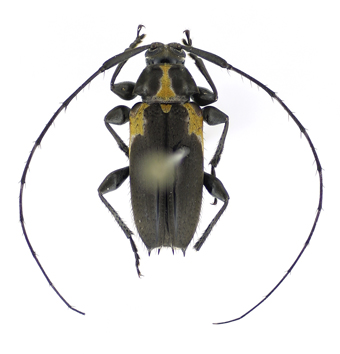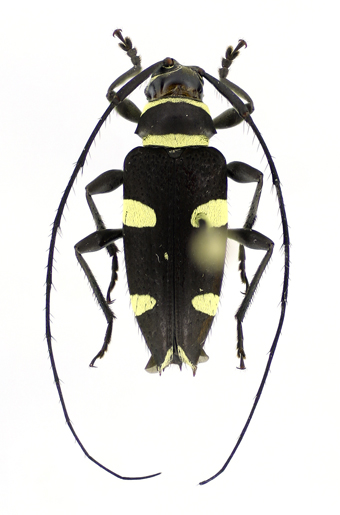 |
Acanthocinini
Classification
Introduction
- The tribe Acanthocinini Blanchard, 1845 currently contains ~2,000 species in 386 genera. Photographs of 60 exemplar specimens are currently available for this tribe.
Diagnostic Features of Adults
- Body small to moderate-sized, approximately 10-40 mm; generally elongate, rarely ovoid; body with or without metallic reflection. Eyes generally reniform, complete (not completely divided into upper and lower lobes). Antennae filiform, unarmed; antennae long, generally extending beyond elytral apices by several segments. Head without distinct lateral or anterior projections. Pronotum shape variable, from cylindrical (distinctly longer than wide) to transverse (distinctly wider than long); lateral margins of pronotum variable, with or without distinct spines or blunt tubercles. Mesocoxal cavity open to mesepimeron. Wings generally complete, rarely absent or reduced. Legs with tarsal claws smooth; claws broadly divergent (divaricate).
Diagnostic Features of Larvae
- Larva. Form depressed, rather slender. Head strongly depressed, with sides abruptly constricted before or at middle; antennal foramen closed or very narrowly open behind; gena with a conspicuous transverse furrow immediately in front of ocellus. Gula with sutures not raised, but with a small rugose area on each side (bearing two to six setae); six epistomal setae present. Ocellus with pigmented spot indistinct. Mentum distinct from submentum. Antenna two-segmented and bearing a conical, hyaline process. Maxilla with outer margin of palpifer strongly rounded and protuberant. Prothorax with posterior part of pronotum velvety asperate (except in certain North American species of Leiopus). Abdomen with ampullae dull and spiculate or shining and tuberculate. Epipleurum very strongly protuberant on last three segments. Pleural tubercle with sclerotized pits distinct. Spiracles circular, with posterior margin of peritreme with marginal chambers. Adapted from Duffy (1953).
Geographic Distribution of Tribe
Biology and Economic Importance
- Members of this tribe are known from various host plant families. Species of this tribe are potentially invasive outside their native range.
Selected References to Adult Specimens
Selected References to Larvae Specimens
|  |

Alcidion humeralis
(Perty, 1832); dorsal
Cerambycidae:Lamiinae:Acanthocinini
Photograph © A.M. Hodson

Alcidion sulphurifer
(White, 1855); dorsal
Cerambycidae:Lamiinae:Acanthocinini
Photograph © A.M. Hodson

Anisopodus batesi
Gilmour, 1965; dorsal
Cerambycidae:Lamiinae:Acanthocinini
Photograph © A.M. Hodson
All Acanthocinini exemplar species images
|




